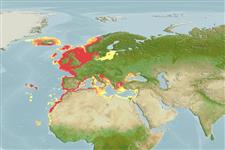Common names from other countries
Environment: milieu / climate zone / depth range / distribution range
Ecología
; rango de profundidad 0 - 400 m (Ref. 78075), usually 15 - 50 m (Ref. 106788). Temperate, preferred 12°C (Ref. 107945); 68°N - 15°N, 32°W - 36°E (Ref. 113881)
Distribución
Países | Áreas FAO | Ecosistemas | Ocurrencias, apariciones | Introducciones
Eastern Atlantic and the Mediterranean Sea. Temperate to polar.
Length at first maturity / Tamaño / Peso / Age
Maturity: Lm ? range ? - ? cm Max length : 11.0 cm SHL macho / no sexado; (Ref. 78075); edad máxima reportada: 8 años (Ref. 8702)
Max depth range from Ref. 113966.
Life cycle and mating behavior
Madurez | Reproducción | Puesta | Huevos | Fecundidad | Larva
Members of the class Bivalvia are mostly gonochoric, some are protandric hermaphrodites. Life cycle: Embryos develop into free-swimming trocophore larvae, succeeded by the bivalve veliger, resembling a miniature clam.
Demir, M. 2003. (Ref. 2754)
IUCN Red List Status (Ref. 130435: Version 2024-1)
CITES status (Ref. 108899)
Not Evaluated
Not Evaluated
Human uses
Pesquerías: comercial
FAO - Acuicultura: producción; pesquerías: landings | FishSource | Sea Around Us
Herramientas
Fuentes de Internet
Estimates based on models
Preferred temperature
(Ref.
115969): 7 - 15.9, mean 10.1 (based on 520 cells).
Resiliencia
Alto, población duplicada en un tiempo mínimo inferior a 15 meses (K=0.51-1.34; tmax=8).
Prior r = 0.56, 95% CL = 0.37 - 0.84, Based on 1 data-limited stock assessment.
Vulnerability
Low to moderate vulnerability (25 of 100).
